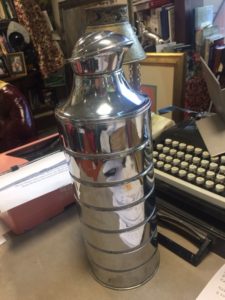 TE asked, “What midcentury collectibles come from the famous place called Hong Kong?” TE recently found, in a local thrift store, a thermos tea or coffee flask, with distinctive rings of chrome. The mark on the bottom pictures a camel, and the mark “Hong Kong.” TE wants to know what was made in the growing 1950’s Hong Kong that we find currently collectible.
TE asked, “What midcentury collectibles come from the famous place called Hong Kong?” TE recently found, in a local thrift store, a thermos tea or coffee flask, with distinctive rings of chrome. The mark on the bottom pictures a camel, and the mark “Hong Kong.” TE wants to know what was made in the growing 1950’s Hong Kong that we find currently collectible.
Today we see a tormented time in Hong Kong, and as we hear of the unrest, we hear of businesses leaving. But the Camel Vacuum Flask Company has existed in Hong Kong for 75 years, and aims to stay. The flask TE found is the classic model of this company, its famous number 147. It stands 16” tall, with a plastic handle, made of die cast chrome-plated zinc aluminum alloy. Camel also made all kinds of flasks, most recognizably toted by generations of school kids and office workers who carried these Camel thermoses through the streets of Hong Kong from 1940 until today.
The company appears proud of its heritage.
In the 1930’s, the Leung family ran boats between Malaya and Hong Kong. This father and son team realized they had no portable vessel in which to carry their hot beverages. The elder Leung developed a flask of spare glass and metal, naming it the Camel, and also named his company Camel. He realized how arduously he needed to work to develop a factory in the Hong Kong of the 1930’s. The name “Camel” reminded him of the hard work to come for his family business. The long haul paid off, as today TE’s flask is one of the midcentury icons of Hong Kong.
Through war, political changes, financial crises, the Leung family manufactured only vacuum flasks. The family still operates the factory in Hong Kong.
Over these 75 years, Camel flasks traveled on bombers, airplanes, warships, and then jet liners. In better days, restaurants and hotels bought flasks, and in calm times, school kids and office workers carried Camel flasks to work. Hong Kong today is again in turmoil, but Camel’s website reports that ‘they believe in Hong Kong.”
Like anything midcentury modern today, collectors clamor for these flasks. Imagine a flask on the midcentury desk in a hip ad agency. Environmentalists point out the benefits of flasks, as opposed to plastic cups and vessels. Hong Kong beer manufacturers use Camel flasks in tasting rooms and bars.
Yet, especially today, Hong Kong is an expensive place to keep a factory going. The Camel Company rebranded its famous Model 147, producing it in mod enamel colors.
What other midcentury icons come from Hong Kong?
During the drought of the1960’s, the “Star Industrial Company, Red A” manufactured plastic pails. They are all over Hong Kong, and this company also makes the iconic red plastic lampshades for the open-air food markets.
Wah Ngai Canvas makes the other icon, the striped blue, red, and white, carrier bags, invented from industrial tarps and then developed as tote bags in the early 1970’s. The stripes are a Hong Kong shopping tradition, and folks from Hong Kong traipsed over to the mainland with these bags stuffed with presents.
Other famous midcentury icons made in Hong Kong and still made there today are the Holga Camera, cheap and plastic-y, and Bruce Lee’s favorite tee-shirt, Lee Kung Mon singlets and undershirts. On the medicine side, the Molasses like cough syrup, Nin Jiom Pei Pai Kao, and, also, for any ailment at all, the Po Chai Pills, very tiny and, as they say, digestible. For beauty, the Two Girls Florida Water and cosmetics. For food production, the inevitable Tuck Chong Sum Kee bamboo steamers, and last but not least, the notable “Watermelon” Toy plastic balls for children. All these products scream Hong Kong.
TE, your Camel Flask is worth $50. I love your question because it puts the idea of midcentury modern in a completely new light. And today, midcentury is where the most valuable “look” resides. This market, as we see with our Hong Kong Camel flask, and the other products of 1960’s Hong Kong, also partakes of the cheaper kitschy element of mid century modern.